Mating systems in animal breeding are broadly classed as inbreeding or outbreeding. Inbreeding is the mating of closely related people, such as siblings or cousins, with the intention of retaining specific desirable features within a population or lineage. While inbreeding can enhance and correct beneficial genetic features, it also raises the risk of detrimental recessive genes being expressed, which can result in decreased fertility, health problems, or less vigor. In contrast, outbreeding is the mating of unrelated or distantly related individuals. This mating systems enhances genetic diversity, lowers the danger of inherited illnesses, and frequently produces offspring that benefit from hybrid vigor. Hybrid vigor often results in increased growth, health, and overall performance.
Table of Contents
Introduction to Mating Systems
Mating systems are essential biological principles that govern the patterns and tactics by which organisms reproduce. In ecological and evolutionary terms, mating systems are divided into two types: inbreeding and outbreeding. Each of these systems has unique mechanisms and consequences for genetic diversity, population dynamics, and species adaption. Understanding these systems is critical to wildlife conservation, agricultural operations, and evolutionary biology research.

Inbreeding occurs when closely related members of a community mate. This mating method frequently results in increased homozygosity, which can have major genetic repercussions. While inbreeding might perpetuate favorable features in a certain environment or population, it can also increase the possibility of expressing harmful genes, thus reducing population fitness. Furthermore, inbreeding can cause inbreeding depression, which is defined as diminished biological fitness due to a lack of genetic variety. This strategy is common in species with restricted dispersion ability or those that live in isolated environments.
Inbreeding
Inbreeding is the mating of closely related individuals, such as siblings, cousins, or parent-offspring pairings. Inbreeding is primarily intended to increase the possibility that offspring would receive good features from a common ancestor.
Advantages:
- Uniformity: It has the potential to promote genetic homogeneity, which is useful in stabilizing characteristics for specific breeding goals.
- Fixing desirable traits: Inbreeding can help “fix” favorable features in a population, making them more consistent across generations.
- Line breeding: A controlled type of inbreeding that strikes a balance between establishing uniformity and limiting harmful consequences.
Disadvantages:
- Inbreeding Depression: This is a widespread issue, as diminished genetic diversity can result in lower fertility, smaller offspring, and higher vulnerability to disease.
- Enhanced expression of recessive genes: Inbred populations have a higher likelihood of expressing harmful recessive genes, which can result in genetic illnesses or unfavorable features.
Outbreeding
Outbreeding is the mating of unrelated individuals, or individuals from different breeds or groups. The fundamental purpose of outbreeding is to increase genetic diversity and bring novel or improved features into a population.
Advantages:
- Heterosis (Hybrid Vigor): Outbreeding frequently produces kids that are stronger, healthier, or more fertile due to increased genetic diversity.
- Reduced chance of genetic diseases: Outbreeding reduces the likelihood of dangerous recessive trait pairing, which can lower the incidence of genetic illnesses.
- Adaptability: Outbred populations have a broader range of genetic features, allowing them to adapt to changing environments or conditions.
Disadvantages:
- Less Predictability: Outbreeding can cause increased genetic variability, making it more difficult to anticipate which traits will be handed down.
- Loss of certain characteristics: Desired features may become diluted or lost over time as additional genes are introduced.
Examples in Agriculture
- Inbreeding: Often used in animals and crops to produce certain, desirable features such as disease resistance or size, however it is usually done in a controlled setting to avoid undesirable consequences.
- Outbreeding: Crossbreeding various pig breeds to create offspring with increased growth rates, fertility, or adaptability is a common method for improving hybrid performance.
In essence, inbreeding and outbreeding are the two main mating systems utilized to manage genetic features in animal breeding. Inbreeding concentrates positive features, but it can also cause inbreeding depression owing to decreased genetic variety. Outbreeding, on the other hand, promotes genetic diversity, which improves health and adaptability through hybrid vigor, but it may dilute some fixed features. Breeders frequently balance these mating systems based on their objectives, with inbreeding providing trait stability and outbreeding enhancing overall population fitness.
Frequently Asked Questions
What is inbreeding, and how is it done?
Inbreeding refers to the mating of genetically related individuals, such as siblings, cousins, or close relatives. It seeks to improve genetic homogeneity and fix specific desired features within a population.
What is outbreeding, and how is it performed?
Outbreeding, also known as outcrossing, is the mating of unrelated individuals, or individuals from different breeds or groups, in order to increase genetic variety.
Related Articles

